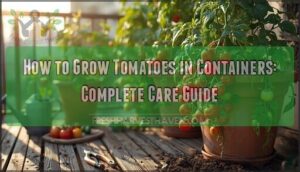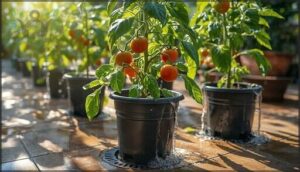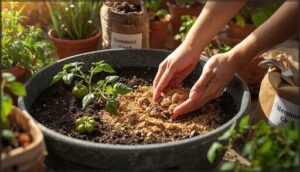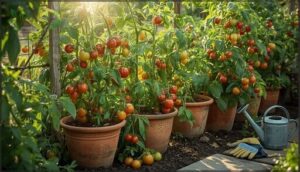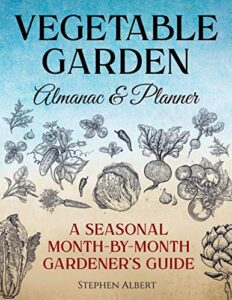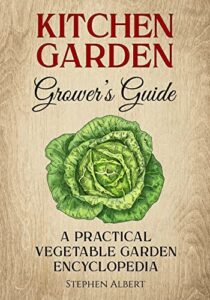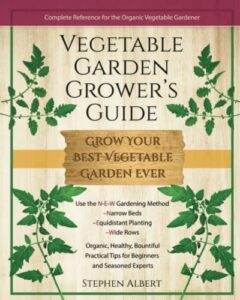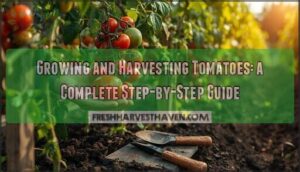This site is supported by our readers. We may earn a commission, at no cost to you, if you purchase through links.
You don’t need acreage to grow ripe, sun-warmed tomatoes. A single 5-gallon pot on a balcony or patio can yield 20 pounds of fruit per season—enough to make any grocery store tomato taste like cardboard by comparison.
Learning how to grow tomatoes in containers opens up gardening to anyone with a sunny spot and a willingness to water regularly. Container growing gives you control over soil quality, drainage, and placement that ground gardeners can only dream about.
When you choose the right variety, provide adequate depth for roots, and maintain consistent moisture, you’ll harvest tomatoes that burst with flavor from summer through first frost.
Table Of Contents
- Key Takeaways
- Benefits of Growing Tomatoes in Containers
- Choosing Tomato Varieties for Containers
- Selecting and Preparing Containers
- Essential Tomato Plant Care in Pots
- Top Guides for Container Tomato Success
- Frequently Asked Questions (FAQs)
- How deep do containers need to be for tomatoes?
- Why put baking soda around tomato plants?
- What’s the best way to grow tomatoes in pots?
- How often do you put Epsom salt on tomatoes?
- Should you water tomato plants in containers everyday?
- Do you pick the yellow flowers off tomato plants?
- What is the best way to plant tomatoes in pots?
- What is the secret to growing tomatoes?
- How do you grow a tomato plant in a container?
- Can a tomato grow in a container?
- Conclusion
Key Takeaways
- Choosing compact or bush tomato varieties and planting them in containers at least 12 inches deep lets you grow flavorful tomatoes even in small spaces.
- Consistent watering, full sun exposure, and regular feeding with balanced fertilizer are essential for healthy plants and high yields.
- Proper drainage, quality potting soil, and support systems like cages or stakes help prevent root rot and keep plants productive.
- Portable containers allow you to optimize sunlight, protect plants from harsh weather, and make harvesting easier right outside your door.
Benefits of Growing Tomatoes in Containers
Growing tomatoes in containers opens up new possibilities for gardeners who face space limitations or less-than-ideal growing conditions. Container gardening gives you practical control over your plants’ environment while delivering the same fresh, flavorful harvest you’d expect from traditional in-ground beds.
Let’s look at the specific advantages that make container-grown tomatoes worth your time and effort.
Space Efficiency and Small-Space Solutions
Container gardening transforms even the tiniest balcony into a productive space. Studies show urban households increased food production by 60% using containers and raised beds. You don’t need a backyard—dwarf varieties thrive in hanging baskets and 5-gallon pots.
Vertical gardening techniques let you stack and climb plants upward, maximizing yield per square foot. Small-space gardening techniques and microgardening adoption prove economic viability, making fresh tomatoes accessible wherever you live.
For busy individuals, self-watering systems can greatly reduce daily watering needs.
Sunlight Optimization and Portability
Beyond saving space, containers let you chase the sun. You can wheel or carry your pots to capture those essential 6 to 8 hours of full sun exposure tomatoes crave.
Studies show portable potting increases effective light by 15-20%, improving yields greatly. Moving plants also prevents sunscald during scorching afternoons and facilitates proper hardening protocols, reducing transplant shock by half while optimizing light mobility throughout the season.
For best results, use continuous-release fertilizer to help your tomatoes thrive.
Early Season Starts and Weather Protection
Starting tomato seedlings indoors 6 to 8 weeks before frost gives your transplanting tomato seedlings a powerful head start. This temperature control strategy boosts early yields while your watering schedule and seed starting timing set the stage for vigorous growth.
Containers with row covers or water walls extend your growing season by protecting against spring cold snaps down to 28°F, letting you plant earlier and harvest sooner.
Convenient Access and Harvesting
Once you’ve worked through early-season planning, you’ll find harvesting ease becomes one of your biggest rewards. Containers position fruits at waist height, reducing bending by 80% and cutting harvest time by 25%.
Compact varieties keep tomatoes within arm’s reach, while portable pots allow 360-degree access, so you can harvest ripe tomatoes right outside your kitchen door—no stooping required.
Choosing Tomato Varieties for Containers
Not all tomato varieties perform equally well in containers. Your choice between determinate and indeterminate types will shape your plant’s size, support needs, and harvest pattern.
Let’s look at the characteristics of each type and which specific varieties deliver the best results in pots.
Determinate Vs. Indeterminate Tomatoes
Your success with growing tomatoes in containers hinges on understanding growth habits. Determinate varieties grow bush-like to 4-5 feet, stop vertical growth after fruiting, and yield 10-20 fruits over 4-5 weeks—perfect for 5-gallon pots. Indeterminate tomatoes vine continuously to 6-12 feet, produce hundreds of fruits until frost, and demand 15-25 gallon containers with trellises.
Consider your container size, harvest patterns, pruning needs, and yield potential when selecting tomato varieties for container gardening.
Best Compact and Bush Varieties
Compact determinate tomatoes and bush varieties excel in containers, bringing generous harvests without towering growth. Dwarf cultivars like those from the Dwarf Tomato Project fit 5-gallon pots beautifully, while patio hybrids such as Bush Early Girl and Patio Princess stay under 24 inches yet deliver medium-sized fruits.
AAS winners like Lizzano F1 and Fantastico thrive in hanging baskets, and Extension picks consistently perform across limited root volumes.
High-Yield and Specialty Options
Looking for tomatoes that deliver big flavor and serious harvests? Cherry tomatoes like Sungold reach seven feet in 16–18 inch pots, yielding up to 10 pounds per plant. Heirloom varieties such as Black Cherry fill buckets from just two plants when grown in 12–18 gallon containers.
Paste tomatoes like Sunrise Sauce and Roma thrive in medium pots, while micro dwarf varieties—needing only 3/4 to 1 gallon—produce surprisingly well indoors, with four to five plants matching one standard tomato’s output.
Selecting and Preparing Containers
Your tomato plant’s container is just as important as the variety you choose—it shapes root health, moisture retention, and overall productivity. The right pot gives your plant room to grow strong roots while keeping watering manageable throughout the season.
Here’s what you need to know about container size, materials, drainage, and soil to set your tomatoes up for success.
Ideal Container Size and Depth
Container size for tomatoes isn’t negotiable—your plant’s entire future depends on it. Selecting a large pot with adequate depth directly influences root expansion needs and, ultimately, volume vs. yield ratios.
Here’s what proper container sizing delivers:
- Determinate varieties thrive in 5-gallon containers with 12-inch depth
- Indeterminate types demand 15-gallon or larger pots for vigorous growth
- Minimum 12-inch depth prevents root-binding and nutrient deficiencies
- 18-24 inch depth bolsters maximum fruit production in tall varieties
- Drainage importance increases with container volume—larger pots retain consistent moisture
Growth stage sizing matters too. Start seedlings in 1-gallon containers, then scale up to 5 gallons before flowering. For peak fruiting, indeterminate tomatoes perform best in 15-20 gallon capacities—production increases noticeably with pot size.
Best Materials for Tomato Pots
Your container material shapes every watering session and root health outcome you’ll encounter. Plastic vs. clay isn’t just aesthetics—white polythene bags deliver 2.36 kg per plant compared to 1.76 kg in clay pots. Fabric grow bags air-prune roots, increasing absorptive capacity by 4.7 times. Metal containers heat stress roots in summer, while porous textile pros include low cost yet reduced yields. Buried clay pots excel in moisture retention.
Selecting appropriate containers means balancing drainage, temperature control, and your climate’s demands.
Ensuring Proper Drainage
Without proper drainage, your tomato roots drown in standing water—literally. Drill multiple holes totaling 1–2 square inches in the container bottom to prevent root rot. Sidewall overflow outlets 0.25–0.5 inches above the base prevent perched water buildup while maintaining oxygenated conditions.
Raise pots with risers to assure runoff control, and promptly empty saucers after watering. Retrofitting pots with adequate hole size transforms failure into thriving growth.
Choosing Quality Potting Soil and Enhancements
Garden soil compacts and traps pathogens, so you’ll want soilless potting soil instead. A peat-perlite or coir-based mix with composted pine bark keeps the growing medium aerated and prevents soil compaction. Aim for a pH of 5.8–6.8 to meet nutrient requirements. If using coir, rinse it first to avoid coir salt issues.
Adding 15–45% compost boosts yield—functional amendments like these improve soil drainage and deliver steady nutrition all season.
Essential Tomato Plant Care in Pots
Once your tomato plants are settled into their containers, they’ll need consistent attention to produce a healthy harvest. The right combination of sunlight, water, nutrients, and support makes all the difference between a struggling plant and one loaded with fruit.
Here’s what you need to focus on to keep your container tomatoes thriving throughout the growing season.
Sunlight and Temperature Requirements
To produce flavorful tomatoes, you need full sun—aim for six to eight hours of direct sunlight daily. Place your containers in a sunny location, such as south- or west-facing spots, to meet these sunlight requirements for tomatoes.
Monitor temperature thresholds closely: daytime temperatures between 70°F and 82°F improve growth, while heat stress above 85°F reduces fruit set. Cold stress below 50°F slows development.
When providing adequate sunlight isn’t possible outdoors, artificial lighting offers an alternative.
Watering Techniques and Schedules
Once you’ve dialed in sunlight, watering becomes your next priority. Container tomatoes need consistent moisture—1 to 2 inches weekly—but pot drying rates vary dramatically. Check soil daily during heat waves above 85°F, when water needs jump 25–50%.
Follow this watering schedule:
- Water transplants daily for the first week
- Vegetative stage: every 2–3 days, 1–1.5 inches
- Flowering phase: 1–2 deep waterings weekly
- Ripening stage: every 3–4 days
- Cool spring (60–70°F): every 4–5 days
Inconsistent watering causes 90% of blossom end rot cases.
Inconsistent watering triggers 90% of blossom end rot in container tomatoes
Fertilizing for Maximum Yield
Container tomatoes are hungry plants—your fertilizing schedule makes or breaks harvest size. Start feeding two weeks after transplanting, when potting soil’s built-in nutrient supply runs out.
Use balanced 20-20-20 fertilizer weekly until flowering begins, then switch to high-potassium formulas like 9-15-30 to boost fruiting. Add calcium-rich options (8% calcium minimum) to cut blossom end rot by 15–20%.
Organic fish emulsion or synthetic water-soluble powders both work—consistency matters most for maximum yield.
Supporting, Pruning, and Training Plants
Supporting your plants properly keeps stems from snapping under heavy fruit loads—indeterminate tomatoes especially need 6–7 foot cages or 8-foot stakes driven 12 inches deep. Pruning impacts yield: removing suckers weekly boosts fruit size by 25%, though unpruned plants produce 38% more pounds of smaller tomatoes. Training techniques like single-stem methods and figure-8 ties improve container harvests.
- Install stakes 4 inches from stems at planting to avoid damaging roots later
- Use tomato cages with 6×6 inch openings so your hands reach fruit easily
- Try the Florida basket weave system with twine loops every 12 inches on posts
- Remove lower leaves touching soil weekly to improve airflow around container plants
- Top indeterminate plants by cutting the top 4 inches one month before frost
Preventing Pests, Diseases, and Root Issues
Without proper pest identification and disease control, your container tomatoes won’t thrive. IPM strategies cut insecticide use by 82%, while weekly scouting boosts yields 6–8% through early detection.
Root health depends on well-drained mixes with perlite to prevent root rot—containers under 14 inches pack roots dangerously.
Control aphids, spider mites, and hornworms before they slash production, and maintain consistent moisture plus calcium to avoid blossom end rot.
Top Guides for Container Tomato Success
Growing tomatoes in containers can feel straightforward once you’ve got the basics down, but the right reference guide makes all the difference when questions pop up mid-season. Whether you’re troubleshooting yellow leaves or planning next year’s varieties, having a trusted resource on hand keeps your confidence high.
Here are four practical guides that cover container tomato growing from start to harvest.
1. Tomato Grower’s Answer Book Guide
You’ll find nearly 400 answers to your container gardening questions in Stephen Albert’s “Tomato Grower’s Answer Book.” This guide’s comprehensiveness shines through 28 well-organized sections covering everything from container size selection to specific techniques like pruning schedules and support methods.
The book’s 120 color photographs serve as excellent visual aids, making complex concepts easier to grasp.
With practical advice on soil amendments, watering schedules, and pest management, it’s no wonder reader reception averages 4.2 stars—you’re getting proven strategies for optimizing tomato production in pots.
Best For: Home gardeners looking to grow tomatoes in containers who want quick answers to specific problems without wading through dense technical manuals.
- Nearly 400 questions answered across 28 sections means you can find solutions fast, whether you’re dealing with watering issues, pest problems, or choosing the right container size.
- 120 color photos make it easy to identify problems and understand techniques visually, which beats text-only guides when you’re actually standing in your garden.
- Works for beginners and experienced growers alike with practical advice on everything from soil mix ratios to pruning schedules and integrated pest management.
- The Q&A format might feel choppy if you prefer reading straight through rather than jumping around to specific topics.
- Focuses mainly on warmer climates, so if you’re growing in a greenhouse or colder region, you’ll find limited guidance for your situation.
- Some readers find the content too basic and wish it went deeper into the science behind the techniques.
2. Vegetable Garden Almanac and Planner Guide
You’ll get the most from your container tomato harvests when you align planting schedules with Old Farmer’s Almanac forecasts and moon phase guidance. This planner integrates weather data from your zip code, automatically calculating transplant dates and succession planting windows for continuous production.
The almanac benefits extend beyond tomatoes—you’re getting a complete vegetable gardening system with bi-monthly reminders, fertilizer planning schedules, and drag-and-drop calendars that adapt growing season tasks to your local frost dates and USDA zone requirements.
Best For: Beginner to experienced gardeners who want a comprehensive year-round planting guide with customizable worksheets and seasonal charts to maximize their vegetable harvests.
- Includes 24 charts and customizable worksheets that help you plan your garden month-by-month with automatic date calculations for seeding, transplanting, and harvesting based on your specific location and frost dates.
- Provides bi-monthly email reminders and drag-and-drop calendar tools that adapt to your USDA zone, making it easy to schedule succession plantings and never miss optimal planting windows.
- Covers everything from container sizing (5-gallon for determinate, 10-20 gallon for indeterminate tomatoes) to fertilizer schedules and moon phase planting guidance using a 200-year almanac formula.
- Contains only hand-drawn illustrations with no color photos, which may disappoint gardeners who prefer visual learning with high-quality images of plants and techniques.
- The 1.21-pound weight and 8.5 x 11-inch dimensions make it less portable than smaller pocket guides for reference while actually working in the garden.
- Advanced gardeners might find the beginner-friendly approach lacking in technical terminology and in-depth scientific explanations of growing methods.
3. The Kitchen Garden Grower’s Guide
When you’re looking for guidance that connects container gardening tips with broader vegetable gardening wisdom, this 409-page book overview covers everything from planting to storing produce.
Growing tomatoes in containers becomes more manageable when you understand climate adaptations and crop preparation methods specific to your region. The guide walks you through optimizing tomato production alongside other crops, offering growing methods for different climates.
While it lacks color photos, you’ll find practical answers for tomato plant care and troubleshooting common challenges.
Best For: Gardeners who want a comprehensive reference for growing vegetables and herbs across different climates, whether they’re just starting out or looking to deepen their knowledge.
- Covers the full growing cycle from planting to harvesting and storage, plus includes helpful troubleshooting tips for common problems.
- Organized by vegetable type, making it easy to find exactly what you need when planning your garden.
- Works for different climates and regions, so you can adapt the advice to your specific location.
- No color photos or graphics, which makes the book feel visually dull and harder to follow for visual learners.
- Light on images and planning tools compared to what some gardeners expect from a modern gardening guide.
- High return shipping costs if the book doesn’t meet your needs, which is worth considering before purchasing.
4. Vegetable Garden Grower’s Guide Book
Stephen Albert’s N-E-W vegetable gardening method brings a fresh perspective to growing tomatoes in containers and beyond. This 372-page book offers practical vegetable growing tips for over 40 crops, making container gardening tips actionable for any space.
You’ll discover techniques for extending the growing season, pest disease management strategies, and homegrown vegetable preservation methods. While the $45.40 digital format may not suit everyone, the extensive container vegetables guidance connects well with tomato-specific care needs, helping you troubleshoot challenges from planting through harvest.
Best For: Gardeners who want a comprehensive guide to growing vegetables organically using proven methods, whether they’re working with containers on a balcony or a large backyard plot.
- Covers over 40 vegetables with detailed planting, growing, and harvesting advice, plus tips on preserving your harvest
- Includes Stephen Albert’s N-E-W gardening method along with season-extension techniques and pest management strategies
- Works for any skill level and garden size, from small container setups to expansive outdoor spaces
- Only available in digital format, which might not appeal to readers who prefer physical books
- At $45.40, the price is higher than many gardening guides on the market
- Doesn’t specifically address regional climate challenges or location-specific growing conditions
Frequently Asked Questions (FAQs)
How deep do containers need to be for tomatoes?
Think of your tomato’s roots as needing room to stretch—most containers should be at least 12 inches deep, though larger pots (15–18 inches) boost root depth impact, support variety depth needs, and improve drainage considerations for best soil volume.
Why put baking soda around tomato plants?
You put baking soda around tomatoes to suppress mildew, prevent blight, adjust soil pH, and deter pests.
It raises soil pH, limits plant diseases, and improves nutrient content, but overuse causes leaf burn and disrupts fertilizing routines.
What’s the best way to grow tomatoes in pots?
Growing tomatoes in pots is like crafting a custom home for your plants. Choose compact varieties, use a great potting mix, and guarantee full sunlight exposure.
Water consistently, feed with balanced fertilizer, and prune for airflow to prevent tomato plant diseases.
How often do you put Epsom salt on tomatoes?
You can apply Epsom salt every two to four weeks during the growing season at one to two tablespoons per gallon of water.
However, watch for magnesium deficiency indicators before supplementing regularly.
Should you water tomato plants in containers everyday?
You’ll need to water tomato plants in containers every day, especially as they mature and fruit. Watering frequency depends on container size, environmental factors, and drainage importance.
Mulch benefits include slowing evaporation—helpful for container gardening in hot weather.
Do you pick the yellow flowers off tomato plants?
Don’t pick yellow flowers from determinate tomatoes—they need every blossom for fruit production.
For indeterminate types, early flower removal benefits root growth, but only on young plants.
Temperature pollination effects and blossom drop can impact pollination success rates.
What is the best way to plant tomatoes in pots?
Imagine a tomato seedling stretching its roots in fresh potting soil. Start with a roomy container, plant deep for strong roots, use well-draining soil, water thoroughly, and keep in sunlight.
Early care shapes healthy tomatoes in pots.
What is the secret to growing tomatoes?
The secret to growing tomatoes lies in matching ideal conditions with smart variety selection, mastering container secrets like size and drainage, and dialing in watering techniques and fertilization methods.
Consistency in care makes container tomato gardening truly productive and rewarding.
How do you grow a tomato plant in a container?
Tomato triumphs start with a spacious container—15 gallons is ideal. Place it in full sun, use quality soil, and water daily in hot weather.
Fertilize with balanced NPK, prune gently, and select compact varieties for container tomato gardening success.
Can a tomato grow in a container?
Yes, a tomato can thrive in a container. With proper potting soil, good drainage, and six to eight hours of sunlight, tomatoes in pots show strong yield potential, healthy root development, and improved disease control—even with space constraints.
Conclusion
Sunshine, soil, and steady care—these three simple steps turn a balcony into a bounty. With practical know-how on how to grow tomatoes in containers, you’re equipped to nurture vigorous vines and savor the freshest fruit. Each pot becomes a personal patch, offering flavor that far surpasses store-bought options.
Consistency counts: water wisely, feed faithfully, and prune patiently. Your harvest will reflect your attention. Container gardening proves that even small spaces can yield big rewards, season after season.

